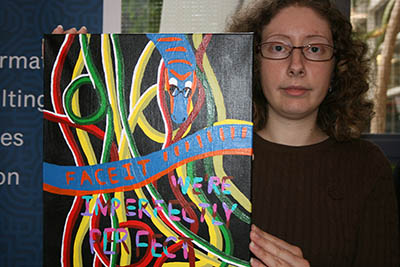
BY REBEKAH OLIVEIRA
They are Friends Accepting Challenges and Endeavoring to Improve Themselves (FACE IT).
For Sheridan students with Autism Spectrum Disorder (ASD) the FACE IT club is a safe place that feels like family.
“This is a good way to make friends. You don’t have to worry about being judged about anything,” said early childhood education student and FACE IT member Nicole Bezeau.
The club held an event April 2 in hopes of raising autism awareness.
“We’re hoping to shed some light on autism within the Sheridan community,” said student services faculty member Janice Galloway. “Today is about raising awareness and raising awareness of our group because a lot of students haven’t registered with a conseller or accessible learning. There isn’t a lot of education about autism.”
Galloway said Sheridan has the highest number of high functioning autistic students in Ontario.
In October 2012, Canada passed the World Autism Awareness Day (WAAD) bill, officially recognizing April 2 as WAAD. It aims to raise awareness of and support for autism knowledge and early diagnosis.
The F.ACE IT Club was started seven years ago by Sheridan student services councilor Tae Hwang. Galloway has been with the group for two years and said the club gives students diagnosed with Autism Spectrum Disorder (ASD) a safe place to be themselves.
The club’s members have been diagnosed with high functioning autism formally known as Asperger’s Syndrome. Based on severity levels, the Diagnostic Statistical Manual (DSM) now classifies all diagnoses under the umbrella term Autistic Spectrum Disorder (ASD).
“As of last year it’s not Aspergers its ‘high function autism’, but we were all diagnosed back when it was still considered Aspergers,” said Bezeau.
Bezeau, 20, wasn’t diagnosed with autism until her early teens.
“I was diagnosed with ADHD then it changed to a learning disability. I didn’t get diagnosed with [high functioning autism] until I was 14,” she said.
“It’s a neurological disability,” said third year advanced visual creative arts student Alissa Raimondo, 26.
She was diagnosed with HFA when she was 2 years old and understands the social and academic difficulties.
“In elementary school and high school I struggled a lot. I would have to ask for a lot of assistance. It’s very important to get the help you need.”
Raimondo and Bezeau agree that for students with ASD, FACE IT is a great place to meet new people. They’re a big family and the only requirement for the club membership is having ASD.
“Sometimes it’s very hard to make friends. We have outings and we talk about our problems and feelings. It’s very open,” said Raimondo.
The Autism Canada Foundation says the disorder affects a person’s communication skills and ability to interact in social situations and symptoms vary in severity.
“There’s high functioning autism which means you can still do a lot of things on your own,” said Raimondo. “You’re independent but there are still some tasks you have trouble understanding or need assistance with.”
“Low functioning is when you need constant supervision”, she said. “You need attendees to help you. There’s actually more [people with] high functioning than low functioning [autism].”
Common symptoms of high functioning autism are literal and logical thinking, difficulty understanding social cues, not being able to adjust to changes in routines and speech and language impairments.
“A lot of people have different symptoms and some are more severe than others,” said Raimondo. Sometimes you can’t understand the expression on people’s faces or you have difficulty expressing your own emotions and people think you’re cold or rude.”
“Just because we don’t have a normal life doesn’t mean we don’t have a life.”
